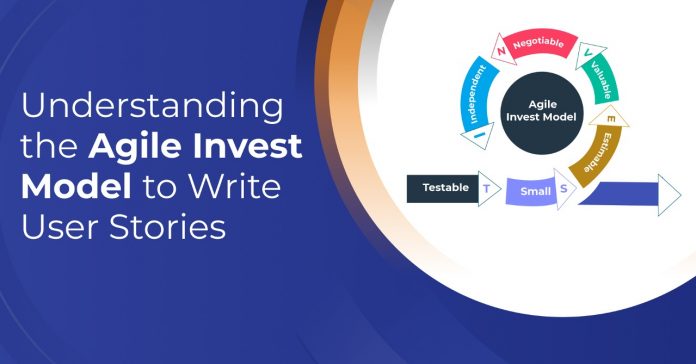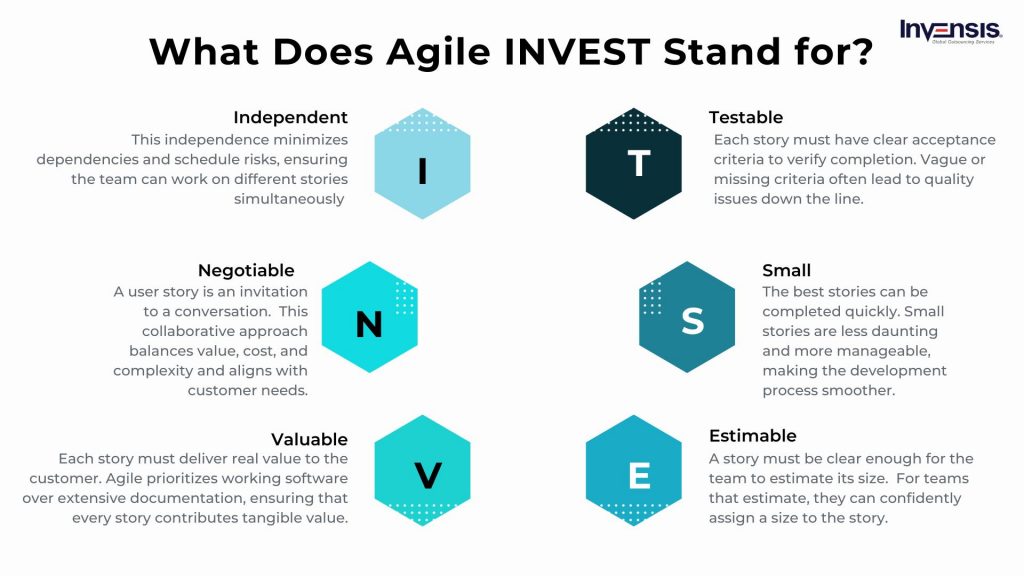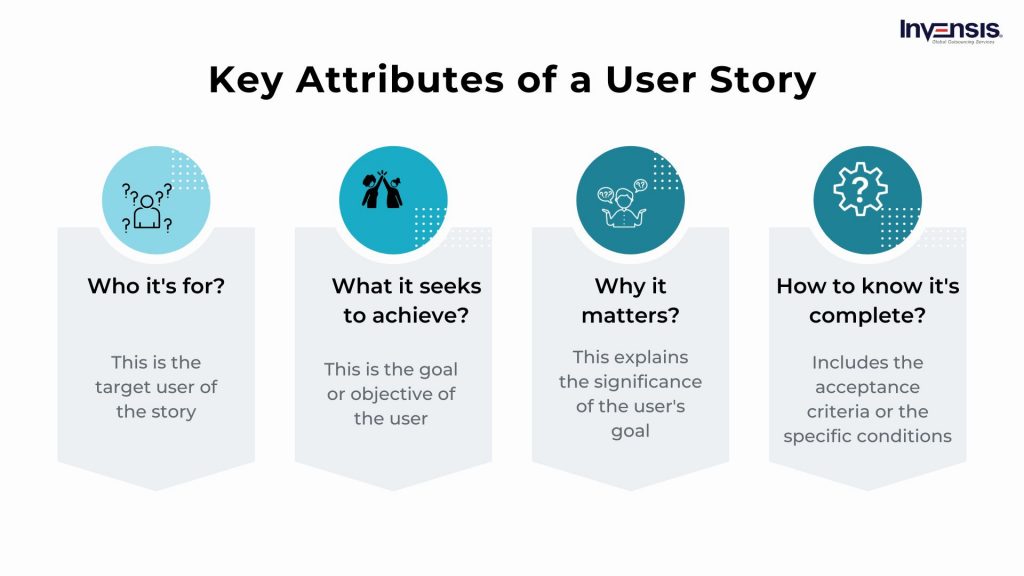
As an aspiring agile practitioner, you know that writing user stories is more crucial than anything else. But what if there is a path to mastering this criticality? Enter the agile INVEST model, a straightforward yet powerful tool to transform how you approach user stories.
This blog offers insights and practical tips. We’ll explore the agile INVEST model – a critical pillar in crafting user stories that resonate with your team and drive your project toward success.
Table of Contents:
- What Does Agile INVEST Stand For?
- Origin of Agile INVEST Model
- What is a User Story?
- Understanding Agile INVEST Criteria
- User Stories Examples Incorporating Agile INVEST Criteria
- Conclusion
What Does Agile INVEST Stand For?
In Agile, writing user stories is like crafting a roadmap for successful software development. But how do we ensure these stories are good and great? That’s where the INVEST principle comes into play. Conceived by Bill Wake in an Extreme Programming article back in 2003, INVEST is a useful criterion in Agile story writing.
INVEST Acronym: Breaking Down the Elements
INVEST is an acronym that stands for Independent, Negotiable, Valuable, Estimable, Small, and Testable. This framework is essential for creating high-quality, specific user stories.
Independent
Think of each user story as a unique puzzle piece. It should stand alone, conceptually distinct from others, and not dependent on the completion of other stories. This independence minimizes dependencies and schedule risks, ensuring the team can work on different stories simultaneously without being held back.
Example:
If Story A must be completed before Story B can start, and Story A is delayed, the whole project risks falling behind. Independence avoids such pitfalls.
Negotiable
A user story is an invitation to a conversation. It’s not set in stone but evolves as the team discusses, gaining clarity and context. This collaborative approach balances value, cost, and complexity and aligns with customer needs.
Example:
Imagine a user story initially focusing on adding a chat feature to a social media app. As the team discusses, they realize adding video functionality could significantly enhance user engagement. The story is adjusted to include this feature, showcasing the negotiable nature of the story, which evolves based on team insights and customer value.
Valuable
Each story must deliver real value to the customer. It’s all about meeting customer needs effectively. Remember, Agile prioritizes working software over extensive documentation, ensuring that every story contributes tangible value.
Example:
Consider a user story about implementing a one-click checkout process in an e-commerce application. This feature directly addresses a common customer pain point: lengthy checkout procedures.
Its completion adds value by simplifying the shopping experience and potentially increasing sales.
Estimable
A story must be clear enough for the team to estimate its size. This doesn’t necessarily mean exact hours or days but rather a relative understanding, like comparing clothing sizes. For teams that estimate, they can confidently assign a size to the story.
Example:
Suppose a team is presented with a story to integrate a new payment gateway into their system. The team members, familiar with similar integrations, can estimate that this task is a ‘medium’ size compared to smaller tasks like UI tweaks and larger ones like building a new product feature from scratch.
Small
The best stories can be completed quickly – think a few days at most. This approach increases the likelihood of completion and keeps momentum high. Small stories are less daunting and more manageable, making the development process smoother.
Example: A user story focused on adding a password strength indicator to the user registration form of a website is a good example of a small story. It’s a well-defined, concise task that can be completed quickly, making it manageable and less complex.
Testable
Finally, each story must have clear acceptance criteria to verify completion. It’s about having concrete tests that can be passed, ensuring the story meets its goals. Vague or missing criteria often lead to quality issues down the line.
Example:
Imagine a user story that aims to ensure that a new blog feature on a website loads within two seconds. The acceptance criteria could include a test measuring page load time under various conditions.
The story is considered complete and testable if the page consistently loads within the specified time.
By embracing the INVEST principle, Agile teams can write user stories that are both good and exceptional. These stories become powerful tools for achieving efficient, effective, and high-quality software development.
Enroll in Invensis Learning’s top Agile Certification Courses and master agile INVEST principle!
Origin of Agile INVEST Model
The criteria of agile INVEST model, is a cornerstone in Agile methodology for writing effective user stories, originated from the insights of XP (Extreme Programming) expert Bill Wake. His pioneering thoughts were first shared in a blog titled “INVEST in Good Stories and SMART Tasks.” This post laid the foundation for a widely adopted approach in Agile circles.
Bill Wake’s initial formulation sparked a trend in the Agile community, leading to various interpretations and adaptations of the INVEST criteria. Over time, as Agile methodologies evolved and diversified, so did the understanding and application of the INVEST principles.
This evolution is a testament to the Agile philosophy of adaptability and continuous improvement.
Interestingly, even Bill Wake himself has revisited and revised the INVEST criteria. For instance, in his recent works, the “S” in INVEST, which originally stood for ‘Small,’ has been reinterpreted as ‘Scalable.’ This shift reflects the dynamic nature of Agile practices and the need to stay relevant and effective in a rapidly changing technology landscape.
In exploring the INVEST criteria, we’ve distilled each element into a single, concise sentence. This approach is designed to make the criteria easy to remember and apply, catering to beginners and seasoned Agile practitioners.
The goal is to provide a clear, straightforward understanding of each criterion, ensuring that they serve as practical guides in writing user stories in the Agile world.
What is a User Story?
In agile software development, a user story is a fundamental building block, yet it’s common for teams, especially those new to Agile, to grapple with writing them effectively.
A user story is a tool used to capture a description of a software feature from an end-user perspective. It focuses on the type of user, what they want, and why.
Key Attributes of a User Story
A well-crafted user story typically encompasses several important attributes:
- Who it’s for?: This is the target user of the story. It’s often expressed as a persona or user type, clearly showing who will benefit from the feature.
- What it seeks to achieve?: This is the goal or objective of the user. It outlines what the user wants to accomplish with the feature.
- Why does it matter?: This explains the significance of the user’s goal. It delves into why achieving this objective is important for the user.
- How to know it’s complete?: This includes the acceptance criteria or the specific conditions that must be met for the user story to be considered complete.
Crafting a User Story: A Popular Approach
A widely used format for writing user stories follows this syntax:
- As a [role/persona/user type],
- I want [goal or action],
- So that [desired result from goal/action].
For instance, in an insurance or healthcare setting, a user story might be:
- As the primary applicant,
- I want to enter the passcode I received from my representative,
- So that I can access my account and ensure my claim information is accurate.
This structure is effective because it includes the key elements: the story’s who, what, and why. Additionally, teams define acceptance criteria as part of the user story, clarifying what ‘done’ means for that specific feature.
User stories are more than just requirements; they are narratives that provide context, clarity, and a human touch to software development. They help teams focus on the user’s needs and the value delivered, ensuring that the end product aligns with what users truly want and need.
Understanding Agile INVEST Criteria
The Agile INVEST criteria are essential guidelines that help teams create effective and high-quality user stories. Each letter in the acronym INVEST represents a key principle that, when combined, ensures that user stories are well-rounded, clear, and actionable.
Understanding and applying these criteria is crucial for Agile teams aiming to optimize their workflow and deliver valuable software efficiently.
Applying INVEST in Agile Environments
Applying the INVEST criteria means that Agile teams are equipped to handle the dynamic and often complex nature of software development more effectively. By adhering to these principles, teams can ensure that each user story contributes positively to the project, aligning with the overall goals and delivering real value to the end user.
Understanding and implementing the INVEST criteria is not just about following a set of rules; it’s about embracing a mindset prioritizing clarity, value, and collaboration. This approach leads to better planning, more efficient workflows, and, ultimately, a higher-quality product that meets the needs and expectations of users.
User Stories Examples Incorporating Agile INVEST Criteria
User stories are a vital component in Agile development, providing a clear and concise description of a feature from the user’s perspective. By incorporating the INVEST criteria, these stories ensure the development process is streamlined and focused on delivering value.
Below are user stories, including one from a technical project, that illustrate the application of the INVEST criteria.
User Story 1: Cinerama Movie Listing
- As Fiona Film-Fan,
- I want to be able to see what Cinerama is offering,
- So that I can decide if I’ll go there
Acceptance Criteria
- A homepage displays the name, tagline, address, email, and phone number
- The homepage lists the ‘now playing’ movies with details like title, rating, genres, description, cast, crew, and session times
- Users can filter the list by title and rating
- Max Manager can update the ‘now playing’ movies
INVEST Scorecard
- Independent: (yes)
- Negotiable: (yes)
- Valuable: (yes)
- Estimable: (yes)
- Small: (no) (The story might be too large and could be broken down further.)
- Testable: (yes)
User Story 2: Technical Project – Cloud Storage Feature
- As a software developer,
- I want a cloud storage integration in our application,
- So that I can store and retrieve files efficiently
Acceptance Criteria
- Implement a feature allowing users to connect to a specified cloud storage service
- Users can upload and download files from within the application
- The feature supports at least two popular cloud storage services
- Ensure security protocols for data transfer are in place
- The feature is compatible with the existing application architecture
INVEST Scorecard
- Independent: (yes) (This feature can be developed independently of other application features)
- Negotiable: (yes) (The details of how cloud storage is integrated can be discussed and adjusted)
- Valuable: (yes) (Provides significant value to users needing cloud storage access)
- Estimable: (yes) (The team can estimate the effort based on similar past integrations)
- Small: (no) (May require breaking down into smaller tasks, such as supporting one cloud service at a time)
- Testable: (yes) (Can be tested for functionality, compatibility, and security)
In both examples, the user stories are structured to clearly define who the feature is for, what the user wants to achieve, and why it matters. The acceptance criteria further clarify the story’s scope and ensure it is testable.
While both stories score high on most INVEST criteria, the ‘Small’ criterion suggests a need for further breakdown to manage complexity better. This illustrates the practical use of INVEST in guiding effective user story creation.
Conclusion
The agile INVEST principle has been a cornerstone in Agile methodologies, consistently popular among practitioners for its practicality in training and real-world application.
By guiding teams to ensure that each user story is independent, negotiated, valuable, evaluable, scalable, small, and testable, agile INVEST model enhances team alignment and the delivery of customer-centric software. Its enduring relevance is a testament to its effectiveness in improving project management and product outcomes.
To further deepen your understanding and skills in Agile practices, particularly in crafting effective user stories, consider exploring our range of Agile Certification Courses. These courses are tailored to provide practical insights and tools, enhancing your ability to apply Agile principles successfully in your projects.
















